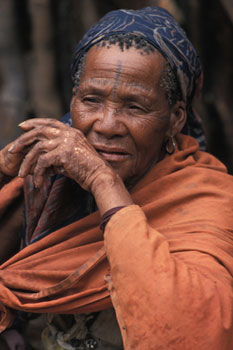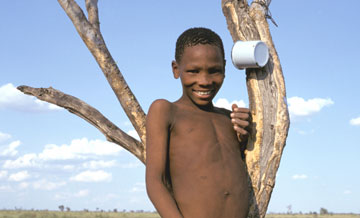The Plight of the Kalahari Bushmen
Air Date: Week of September 17, 2004
The Bushmen of the Kalahari are being squeezed off their ancestral lands to make room for industries like diamond mining and cattle ranching. So, they’ve filed a lawsuit against the government to get their land back. Living on Earth host Steve Curwood talks with Rupert Isaacson author of The Healing Land: The Bushmen and the Kalahari Desert who’s helping to lead the effort. Joining them are two Bushmen, Roy Sesana and Jumanda Gakelebone.
Transcript
CURWOOD: It’s Living on Earth, I’m Steve Curwood. The Bushmen of the Kalahari have traditionally been an isolated culture. Their way of life dates back tens of thousands of years, and they may be the oldest aboriginal tribe of humans. Hunting and healing form the backbone of their society. Until recently, they largely kept to themselves, and rarely had to appeal to the outside world for help.
Now all that’s changed. Thousands of Bushmen, or San, are being squeezed off their ancestral lands, to make room for industries like diamond mining and cattle ranching. In Botswana, this is playing out on a Bushman homeland called the Central Kalahari Game Reserve. The bushmen there have filed a lawsuit against the government to get their land back and they’re looking for support here in the U.S. and at the United Nations.
Rupert Isaacson is helping organize this effort. He’s author of: “The Healing Land: The Bushmen and the Kalahari Desert.” Rupert, welcome back to Living on Earth.
ISAACSON: Thank you for having me back.
CURWOOD: Now, you’ve been traveling across the country with members of the Bushmen of Botswana, two of whom are with you in the studio, Roy Sesana, and his translator, Jumanda Gakelebone. Welcome, both of you.
SESANA (TRANSLATED BY GAKELEBONE): Thanks, welcome you.
CURWOOD: Rupert, let’s start with you. Part of the reason that your group is here in the United States has to do with a particular parcel of land in Botswana, which is called the Central Kalahari Game Reserve. What kind of relationship have the Bushmen – have the San – historically had with this land?
ISAACSON: Well, it’s their ancestral land. You could say – it’s true to say – that really all of southern Africa is originally the San, or Bushmen, ancestral land. But over the course of the last few hundred years they’ve been gradually extinguished, displaced, from almost all of the Subcontinent. And now the traditional culture hangs on in a few spots – in Botswana, Namibia and some of the neighboring countries.
 (Photo: © Survival)
(Photo: © Survival)
So this was a fairly enlightened move that the British government made just before they left Botswana. They took this very remote area the size of Switzerland – the second largest conserved area I think on the continent of Africa – called it the Central Kalahari Game Reserve, and in its mandate, in its constitution, said this is for the Bushmen to continue their hunting and gathering culture in perpetuity, and will protect the ecology to allow this to happen.
CURWOOD: How long do the Bushmen go back on this land?
ISAACSON: The Bushmen culture itself is thought to be the oldest on the planet. Earlier this year an artifact was found – a necklace that is apparently Khoisan Bushmen – on the coast of South Africa. It was dated at 70,000 years old. Which is pretty old (LAUGHS). So how long have they occupied the Central Kalahari Game Reserve? Let’s just say longer than anybody else.
CURWOOD: So, the San, or the Bushmen, have been on this land tens of thousands of years, perhaps more. What has happened recently now?
ISAACSON: In 2002, they were forcibly relocated against their will. This is a process that had actually begun back in the late ‘80s. And then in the ‘90s, the government moved in and took people out of one village, put them outside the reserve in a relocation settlement, where the conditions were pretty dire, and there was a sufficient human rights outcry back then to make the Botswana government back off. However, in 2002, I guess, world attention had gone elsewhere. And they went back in and moved the rest out – all but about a hundred people who have refused to move, who are still in there surviving as best they can.
CURWOOD: Why does the government want to move these people? Why is the government moving the people?
ISAACSON: The governments say that a) this is not a forcible relocation, that they’ve persuaded the Bushmen to move for their own good. They say that they can’t offer them the developments that they need to become modern Botswana citizens inside a game reserve. And that’s more or less about it. However, over the last 30 years or so since independence, really enormous numbers of Bushmen have been relocated and displaced within Botswana. For the creation of new national parks and reserves, diamond mines, and particularly cattle ranching that the European Union poured a lot of money into – the Botswana cattle industry after independence.
And a lot of Bushmen sort of woke up with fences around them, literally finding themselves living as serfs in other people’s cattle ranches. All this of course happened during the apartheid era when Botswana was, if you like, one of the “good people” in Africa, and was sheltering exiles from apartheid and so on. So there wasn’t any attention, really, to these sort of quiet human rights abuses that were going on. And there was no culture of finding a voice among the Bushmen. So these people more or less sort of evaporated. They became scavengers around the outskirts of the towns, a lot of them died, etcetera.
|
|
CURWOOD: Let me turn to you, Roy, and ask you: What about the cultural divide with the Botswana who run the country now? Rupert suggests there is ethnic, there is racial, tensions here. What’s your analysis? SESANA (TRANSLATED BY GAKELEBONE): The true answer is that we as Bushmens, wherever we are and we stay with the Botswana people, they oppress us. There’s racial discrimination. And it’s part of using us as servants. CURWOOD: Now, the government has said that diamond mining, ranching, these things have nothing to do with the issue. And, in fact, that it’s not even forcibly removing your people from your ancestral homelands. What’s your response to these statements, Roy? SESANA (TRANSLATED BY GAKELEBONE): My response to this question is that it’s not the truth. I can say that we’ve been forcibly removed. I am myself right now sitting here talking with you. My home has been dismantled during my absence. They even stopped the services like water. There used to be mobile health, which also stopped. To say that those things … and we have been asked, if you don’t move, you are not going to be given all those services. By so doing there are some who refused to move right now, saying like this, they are not given those services. That shows that there was force. If there was not force, why are those who refuse to move not been given those services? CURWOOD: So no water, no medical help? SESANA (TRANSLATED BY GAKELEBONE): That’s correct. Even I myself was [sic] sometime when I went outside the camp myself, tried to bring water inside to help those who have remained behind. The government officials especially, the Department of Wildlife and National Parks. In their case they stopped me and asked me not to bring inside the water. My elder brother is very sick, who refused to move in [sic]. I’m stopped not to visit and see how he is. Who is saying they did not force us to move? It is not the truth. CURWOOD: Roy, you organized a lawsuit against the government to get your land back. What made you decide to do this? SESANA (TRANSLATED BY GAKELEBONE): I look at the Bushmens and they don’t have rights everywhere in the land, especially in the country, being moved every day. And whereever they are moved I see their culture keep on changing. So this worried me. And then I see if the Bushmen is all going to be moved in [sic] then we’ll, in the end, not have any Bushmen in Botswana. CURWOOD: Now, the government says by moving your tribe, your families, off of this land, that they’re bringing you to a better life. That away from the Central Kalahari Game Reserve there’ll be modern conveniences and such. What’s your understanding of how you and your friends and family live now after being displaced from the game reserve? SESANA (TRANSLATED BY GAKELEBONE): That is not the truth – we are not moved to be developed. In our land we stayed with our culture; we did not have a lot of diseases, which we get from our neighbors and whatever. To me, to be moved to outside of the reserve is to take us to the fire. According to our culture, our land is something which makes us to be rich, and is our life. If you are hungry staying on your land, you know where to go and find what to eat. Where we have been moved – right now to three new settlements – seems like we have been put in custody. CURWOOD: So it’s prison? GAKELEBONE: Yeah, that’s prison, yeah. CURWOOD: What kinds of things can you do now outside of the Central Kalahari Game Reserve to preserve the San culture? What chances do you have to hunt, for example? SESANA (TRANSLATED BY GAKELEBONE): There is nothing we can do to preserve our culture. What I’ve seen is that we’ve been taken outside for prison – that is the thing which we see. And now our kids are taken to school, and they don’t bring good results. They don’t do much in education. We take our kids to school, then they get HIV and pregnancy. But other tribes outside that have been taken – there have been a lot sexual abuse by other tribes with Bushmen. And we have got other children, kids from the different tribes, and all these Bushmen are going to be killed by this disease of AIDS. So I’m afraid that’s all, that we won’t have Bushmen, that’s all. So these new kids which are born are not Bushmen, they’re something else.
|


 (Photo: © Survival)
(Photo: © Survival) 



